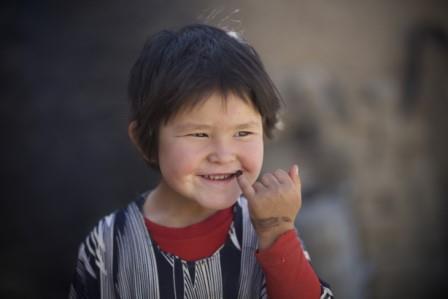 An Afghan child displays her finger, seen stained with ink, as a mark of having been administered the polio vaccine during the first day of a polio vaccination campaign in Bamyan on October 17, 2016. WHO Afghanistan/R.Akbar
An Afghan child displays her finger, seen stained with ink, as a mark of having been administered the polio vaccine during the first day of a polio vaccination campaign in Bamyan on October 17, 2016. WHO Afghanistan/R.Akbar
23 October 2017 – With fewer cases than in any other year in history, the world has its best opportunity yet to end polio for good.
Our Region, and the world, has never been closer to eradicating polio. Wild poliovirus (WPV) transmission is at the lowest levels in history and is limited to a few zones in the 2 remaining polio-endemic countries of the Eastern Mediterranean Region ‒ Afghanistan and Pakistan. Fewer children were paralysed by wild poliovirus in 2016 than in any other year in history (37 cases), and, so far in 2017, only 12 cases of WPV had been reported: 7 from Afghanistan and 5 from Pakistan.
Governments and partners in both countries are implementing robust National Emergency Action Plans, which include innovative strategies to reach chronically missed children and those living in inaccessible areas. Through Emergency Operation Centres, and collaborative approaches between the national programmes, efforts are coordinated and streamlined. High-quality campaigns and innovative methods for reaching every child have cornered the virus and put eradication within reach.
Chris Maher, Manager of WHO’s polio eradication efforts’ in the Eastern Mediterranean, said despite the progress against WPV, significant challenges remain, and it is essential that the world stays committed to ending polio.
“We have come too far to take our foot off the accelerator right now. While we have reasons to celebrate progress in 2017, we still have notable obstacles to overcome,” he said. “Though fewer in number than ever, cases continue to be identified and the virus also continues to circulate in the environment — especially in hard-to-reach areas.”
The current outbreak in the Syrian Arab Republic, Maher said, is a stark reminder of the dangers of immunity gaps, and the need for unhindered access to children in all areas for immunization.
As of 17 October, 52 cases of circulating vaccine-derived poliovirus type 2 (cVDPV2) were confirmed in 3 governorates in Syria. The national programme, supported by WHO, UNICEF and international partners, has carried out an effective immunization response in the affected areas, and there are encouraging signs that the outbreak is coming to an end. But Maher cautions, circulating vaccine-derived poliovirus remains to be a threat to communities with low routine immunization coverage, particularly those in areas of conflict and inaccessibility.
Supplementary immunization activities (SIAs) continue to be carried out in the 2 endemic and 6 at-risk countries across the Region and the programme is focused on strengthening surveillance for acute flaccid paralysis (AFP) and expanding environmental surveillance so we can cast a wider net for poliovirus detection.
To date in 2017, 270 million doses of oral polio vaccine were given in 29 supplementary immunization activities (in the Region) and environmental surveillance has expanded to 5 countries with plans to expand to all at-risk countries in the Region. AFP surveillance continues to improve, with systems reporting more than 16 000 AFP cases in 2016 compared to slightly over 13 000 in 2015, a 21% increase, reflecting improvements in surveillance sensitivity.
This World Polio Day we reflect on the many millions of people behind the 30 year effort to end polio.
“There are so many faces of the polio programme, from dedicated vaccinators to parents who demand the vaccine and donors who commit the funds necessary to finance these critical activities — all of whom have played a key role in achieving the incredible progress made to date,” Maher said.
“These extraordinary efforts have paved the way for not only polio vaccines, but also other critical health services to reach children in some of the most remote areas of the world.”
Related links
Videos on polio eradication in the Region


